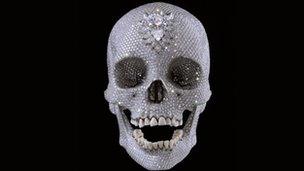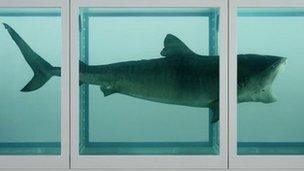Damien Hirst skull to display in Turbine
- Published

For the Love of God features 8,601 diamonds
A £50m Damien Hirst diamond-encrusted skull will be shown in Turbine Hall to accompany a Tate Modern retrospective of his work from 4 April.
For the Love of God will be displayed until 24 June.
The exhibition, featuring his "pickled shark", runs from 4 April to September.
Tate said the skull, appearing for the first time in a UK public gallery, may be viewed "alternatively as a glorious, devotional, defiant or provocative gesture in the face of death itself".
The work, which will be housed in a viewing room in the east end of the Turbine Hall, was sold to an investment group in 2007 with Hirst retaining part-ownership.
He has described For the Love of God, the platinum cast of a 35-year-old 18th century European man covered in 8,601 jewels, as an "uplifting" piece that "takes your breath away".
'Great place'
The skull has previously been shown at Amsterdam's Rijksmuseum, in 2008, and Florence's Palazzo Vecchio, in 2010-2011.
Hirst said in a statement released on Monday that he was "really pleased" the skull would be on display in such a "great place".

The Physical Impossibility of Death in the Mind of Someone Living was commissioned by art collector Charles Saatchi
Tate added: "Visitors will be given the opportunity to view For the Love of God as an independent exhibit or as a culmination of many of the themes revealed in the exhibition."
The display, which surveys the artist's work from the late 1980s onwards, is described as the first substantial Hirst exhibition in the UK.
It will be part of the London 2012 Festival - the grand finale of the Cultural Olympiad.
It features more than 70 of his works, including The Physical Impossibility of Death in the Mind of Someone Living with a suspended shark in formaldehyde.
Works featuring cabinets displaying pills, medical instruments and packaging will also feature as well as paintings from Hirst's spot series.
Other highlights include two-part installation In and Out of Love - which features butterflies and has not seen since since its creation in 1991 - and 1992's Pharmacy.
A Thousand Years 1990, featuring flies living in a rotting cow's head and dying on an insect killer, will also be included.
The British artist, who rejects suggestions his works are a standing joke against the art establishment, first came to public attention with his 1988 Freeze exhibition of his own and fellow students' work in a disused warehouse in London.
Charles Saatchi was among visitors and, within a year, he had bought two of Hirst's medicine cabinet exhibits.
Hirst went on to become a household name partly due to the attention his controversial artworks attracted.
- Published3 March 2011